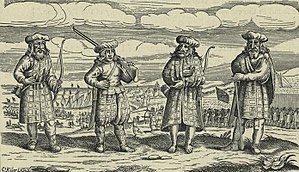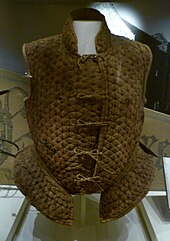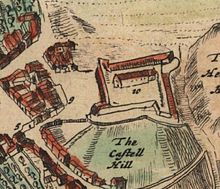Warfare in early modern Scotland

Warfare in early modern Scotland includes all forms of military activity in Scotland or by Scottish forces, between the adoption of new ideas of the Renaissance in the early sixteenth century and the military defeat of the Jacobite movement in the mid-eighteenth century.
In the
There were attempts to create royal naval forces in the fifteenth century. James IV founded a harbour at
In the early seventeenth century large numbers of Scots took service in foreign armies involved in the
At the
Sixteenth century
Royal armies

In the later Middle Ages, Scottish armies were still largely assembled on the basis of common service and
A series of musters or
Weapons included various forms of axes and pole arms, including spears, the
Like most European nations the Scots in this period began to convert from the bow to gunpowder firearms.

The English enjoyed a marked superiority over the Scots in cavalry, particularly with the resurgence of heavy cavalry with their use of demi-lancers. The feudal heavy cavalry had begun to disappear from Scottish armies after Bannockburn in 1314. It was limited by the shortage of suitable horses. James V imported great horses and mares from Denmark in an attempt to improve the quality of Scottish breading stock. In the mid-sixteenth century the Scots still lacked sufficient heavy cavalry. In their place they fielded relatively large numbers of light horse, often drawn from the Borders and usually wearing jacks of leather or mail, mounted on small horses and using light lances. As firearms became available they began to field relatively large numbers of mounted arquebusiers.[13]
Artillery and siege warfare
Gunpowder weaponry fundamentally altered the nature of

There were various attempts to create royal naval forces in the fifteenth century. James IV put the enterprise on a new footing, founding a harbour at
James V entered his majority in 1524. He did not share his father's interest in building a navy, relying on French gifts such as the Salamander, or captured ships like the English

Scottish privateers and
Early seventeenth century
Royal and marque fleets

After the
Covenanter armies

In the early seventeenth century relatively large numbers of Scots took service in foreign armies involved in the
The appointment of Leslie as field marshal avoided a contest between inexperienced nobles for leadership and his reputation made the service by Scottish mercenaries in Covenanter armies more likely. He became an ex offico member of the Tables, enabling him to influence policy and take part in issuing dispatches. Although producing a relatively large and efficiently organised army, it was hastily assembled, and short of money and supplies. The Covenanting regime had to make assessments on parishes and relied on loans from Edinburgh merchants, making a long campaign difficult to sustain. In the view of historian James Scott Wheeler, the first Covenanter army was "marginally trained, irregularly armed, poorly paid and badly supplied", but it proved sufficient to the task.[39]

Between the two Bishops' Wars the Covenanters maintained one regiment of infantry and many of their officers who had drilled the local militias on half pay. The militas were now armed with firearms purchased in the Netherlands. The Tables were replaced with a committee of estates, with wide-ranging powers, and kept to same system of commissioners. One in four able bodied men were able to muster when mobilisation began for renewed confrontation in 1640. The army was paid for by more loans and a new national tax known as the "tenth" or "tenth penny".
Scottish infantry were generally armed, as was almost universal in Western Europe, with a combination of
Royalist armies, like those led by

During the Bishops' Wars the king attempted to blockade Scotland, disrupting trade and the transport of returning troops from the continent. The king planned amphibious assaults from England on the east coast and from Ireland to the west, but they failed to materialise.[39] Scottish privateers took English prizes and the Covenanters planned to fit out Dutch ships with Scottish and Dutch crews to join the naval war effort.[49] After the Covenanters allied with the English Parliament they established two patrol squadrons for the Atlantic and North Sea coasts, known collectively as the "Scotch Guard". These patrols guarded against Royalist attempts to move men, money and munitions and raids on Scottish shipping, particularly from ships based in Wexford and Dunkirk. They consisted mainly of small English warships, controlled by the Commissioners of the Navy based in London, but it always relied heavily on Scottish officers and revenues, and after 1646, the West Coast squadron became much more a Scottish force.[50] The Scottish navy was unable to withstand the English fleet that accompanied the army led by Cromwell that conquered Scotland in 1649–51. The Scottish ships and crews were divided among the Commonwealth fleet.[51]
Fortifications
During the English occupation of Scotland under the Commonwealth, fortresses in the style of the
Later seventeenth century
Restoration army

At the Restoration the Privy Council established a force of an unknown number of infantry regiments and a few troops of horse. The Commonwealth fortresses were abandoned, but garrisons were placed in Edinburgh, Stirling, Dumbarton and

Although Scottish seamen received protection against arbitrary impressment onto English men-of-war under Charles II, a fixed quota of conscripts for the Royal Navy was levied from the sea-coast burghs during the second half of the seventeenth century.[59] Royal Navy patrols were now found in Scottish waters even in peacetime, such as the small ship-of-the-line HMS Kingfisher, which bombarded Carrick Castle during the Earl of Argyll's rebellion in 1685.[60] Scotland went to war against the Dutch and their allies in the Second (1665–67) and Third Anglo-Dutch Wars (1672–74) as an independent kingdom. Scottish captains, at least 80 and perhaps 120, took letters of marque, and privateers played a major part in the naval conflict of the wars.[61]
By 1697 the English Royal Navy had 323 warships, while Scotland was still dependent on merchantman and privateers. In the 1690s, two separate schemes for larger naval forces were put in motion. As usual, the larger part was played by the merchant community rather than the government. The first was the
Early eighteenth century
Royal army

By the time of the act of Union, the Kingdom of Scotland had a
Jacobite armies
The bulk of Jacobite armies were made up of Highlanders, serving in clan regiments. They were 70 per cent of the forces in the 1715 rebellion and over 90 per cent of those in 1745.[67] Most were forced to join by their clan chiefs, landlords or feudal superiors and desertion was a major problem during campaigns.[68] The Jacobites suffered from a lack of trained officers.[69] A typical clan regiment was made up of a small minority of gentlemen (tacksmen) who would bear the clan name.[70] The clan gentlemen formed the front ranks of the unit and were more heavily armed than their impoverished tenants who made up the bulk of the regiment.[68] Because they served in the front ranks, the gentlemen suffered higher proportional casualties than the common clansman.[70] The Jacobites often started campaigns poorly armed. In the rising of 1745, at the Battle of Prestonpans, some only had swords, Lochaber axes, pitchforks and scythes, but arms tended to become more conventional as the campaigns progressed. Only officers and gentlemen were equipped with a broadsword, targe and pistol.[71] After the Battle of Culloden in 1746, the Hanoverian commander the Duke of Cumberland reported that there were 2,320 firelocks recovered from the battlefield, but only 190 broadswords.[72]
References
Notes
- ^ ISBN 0-85115-746-7p. 53.
- ISBN 1-85285-052-3, pp. 9–11.
- ^ ISBN 0-7486-1238-6, p. 58.
- ^ Phillips, The Anglo-Scots Wars, 1513–1550, p. 60.
- ^ a b Phillips, The Anglo-Scots Wars, 1513–1550, p. 61.
- ^ a b Phillips, The Anglo-Scots Wars, 1513–1550, p. 62.
- ^ David Masson, Register of the Privy Council, Addenda 1545-1625, vol. 14 (Edinburgh, 1898), pp. 376-7.
- ^ Phillips, The Anglo-Scots Wars, 1513–1550, p. 63.
- ISBN 1-84603-325-X, p. 23.
- ^ Phillips, The Anglo-Scots Wars, 1513–1550, p. 64.
- ^ Phillips, The Anglo-Scots Wars, 1513–1550, p. 68.
- ^ Phillips, The Anglo-Scots Wars, 1513–1550, p. 69.
- ^ Phillips, The Anglo-Scots Wars, 1513–1550, pp. 69–70.
- ^ ISBN 0-7486-1455-9, p. 76.
- ISBN 1-59884-429-6, p. 156.
- ISBN 0-85263-748-9, p. 27.
- ^ ISBN 0-19-211696-7, pp. 637–8.
- ISBN 0-85976-663-2, p. 235.
- ^ ISBN 0-85976-338-2, p. 45.
- ^ ISBN 90-04-18568-2, pp. 33–4.
- ^ a b J. Grant, "The Old Scots Navy from 1689 to 1710", Publications of the Navy Records Society, 44 (London: Navy Records Society, 1913–14), pp. i–xii.
- ^ Murdoch, The Terror of the Seas?, pp. 36–7.
- ^ a b c Dawson, Scotland Re-Formed, 1488–1587, pp. 181–2.
- ^ Murdoch, The Terror of the Seas?, p. 39.
- ISBN 0-85976-611-X, p. 164.
- ISBN 1-904607-78-0, p. 239.
- ^ Cameron, James V, pp. 152–53.
- ^ Andrea, The Princelie Majestie, pp. 158–9.
- ISBN 1-86232-090-X, p. 181.
- ^ Murdoch, The Terror of the Seas?, pp. 50 and 76.
- ^ a b Murdoch, The Terror of the Seas?, p. 172.
- ISBN 0-14-029724-3, p. 197.
- ^ Murdoch, The Terror of the Seas?, p. 69.
- ^ Murdoch, The Terror of the Seas?, p. 169.
- ^ Murdoch, The Terror of the Seas?, p. 168.
- ISBN 0-19-926149-0, p. 118.
- ^ Murdoch, The Terror of the Seas?, p. 174.
- ISBN 0-415-27880-5, p. 183.
- ^ ISBN 0-415-22131-5, pp. 19–21.
- ^ Wheeler, The Irish and British Wars, 1637–1654, p. 29.
- ^ Wheeler, The Irish and British Wars, 1637–1654, p. 48.
- ISBN 90-04-12823-9, p. 240.
- ISBN 0-521-46686-5, p. 28.
- ISBN 0-901824-92-5, p. 51.
- ISBN 0-7509-2027-0, p. 144.
- ISBN 0-7190-4317-4, p. 148.
- ISBN 0-8108-5100-8, pp. 223–5.
- ISBN 1-84415-128-X, p. 169.
- ^ Murdoch, The Terror of the Seas?, p. 198.
- ^ Murdoch, The Terror of the Seas?, pp. 204–10.
- ^ Murdoch, The Terror of the Seas?, p. 239.
- ISBN 0-7486-0849-4, p. 70.
- ISBN 1-4464-7563-8, p. 283.
- ^ ISBN 0-19-211696-7, pp. 637–8.
- ISBN 0-7486-3335-9, p. 14.
- ISBN 0-85045-059-4, pp. 1–3.
- ISBN 0-19-211696-7, pp. 24–5.
- ISBN 1-84415-405-X, p. 85.
- ISBN 0-8139-3352-8.
- ISBN 0-7486-1790-6, p. 44.
- ^ Murdoch, The Terror of the Seas?, pp. 239–41.
- ISBN 90-04-14711-X, p. 349.
- ^ Grant, "The Old Scots Navy from 1689 to 1710", p. 48.
- ISBN 0-7134-7484-X, p. 38.
- ISBN 0-8108-7497-0, p. 485.
- ISBN 0-19-211696-7, pp. 25–6.
- ISBN 0-19-211696-7, pp. 25–6.
- ^ ISBN 0-85045-432-8, pp. 17–18.
- ISBN 1-85532-158-0, pp. 35–40.
- ^ ISBN 1-85532-660-4, p. 58.
- ^ Reid, Highland Clansman 1689–1746, pp. 20–22.
- ^ Reid, Highland Clansman 1689–1746, p. 50.
Bibliography
- Andrea, T., The Princelie Majestie: The Court of James V of Scotland 1528–1542 (Edinburgh: Birlinn, 2005), ISBN 0-85976-611-X.
- Barratt, J., Cavalier Generals: King Charles I and his Commanders in the English Civil War, 1642–46 (Barnsley: Pen & Sword Military, 2004), ISBN 1-84415-128-X.
- Barratt, J., Cavaliers: the Royalist Army at War, 1642–1646 (Stroud: Sutton, 2000), ISBN 0-7509-2027-0.
- Barthorp, M., The Jacobite Rebellions 1689–1745 (Barthrop: Osprey, 1982), ISBN 0-85045-432-8.
- Brown, M., The Wars of Scotland, 1214–1371 (Edinburgh: Edinburgh University Press, 2004), ISBN 0-7486-1238-6.
- Brunsman, D., The Evil Necessity: British Naval Impressment in the Eighteenth-Century Atlantic World (Charlottesville, VA: University of Virginia Press, 2013), ISBN 0-8139-3352-8.
- Cameron, J., James V (Edinburgh: Tuckwell, 1998), ISBN 1-904607-78-0.
- Campbell, A., A History Of Clan Campbell: From The Restoration To The Present Day (Edinburgh: Edinburgh University Press, 2004), ISBN 0-7486-1790-6.
- Cooper, J., Scottish Renaissance Armies 1513–1550 (Botley: Osprey, 2008), ISBN 1-84603-325-X.
- Coward, B., The Cromwellian Protectorate (Manchester: Manchester University Press, 2002), ISBN 0-7190-4317-4.
- Dawson, J. E. A., Scotland Re-Formed, 1488–1587 (Edinburgh: Edinburgh University Press, 2007), ISBN 0-7486-1455-9.
- Edwards, P., Murdoch, S., and MacKillop, A., Fighting for Identity: Scottish Military Experience c. 1550–1900 (Leiden: Brill, 2002), ISBN 90-04-12823-9.
- Fissel, M. C., The Bishops' Wars: Charles I's Campaigns Against Scotland, 1638–1640 (Cambridge: Cambridge University Press, 1994), ISBN 0-521-46686-5.
- Furgol, E. M., "Warfare, weapons and fortifications: 3 1600–1700" in M. Lynch, ed., The Oxford Companion to Scottish History (Oxford: Oxford University Press, 2001), ISBN 0-19-211696-7.
- Glendinning, M., MacInnes, R., and MacKechnie, A., A History of Scottish Architecture: from the Renaissance to the Present Day (Edinburgh: Edinburgh University Press, 2002), ISBN 0-7486-0849-4.
- Grant, C., The Royal Scots Greys (Botley: Osprey, 1972), ISBN 0-85045-059-4.
- Grant, J., "The Old Scots Navy from 1689 to 1710", Publications of the Navy Records Society, 44 (London: Navy Records Society, 1913–14).
- Grove, D., and Abraham, C., Fortress Scotland and the Jacobites (Batsford/Historic Scotland, 1995), ISBN 0-7134-7484-X.
- Harrington, P., and Chandler, D. G., eds, Culloden 1746, The Highland Clans' Last Charge (Botley: Osprey, 1991), ISBN 1-85532-158-0.
- Leask, A., Sword of Scotland: Our Fighting Jocks (Bradford: Pen & Sword Books, 2006), ISBN 1-84415-405-X.
- Lynch, M., Scotland: a New History (London: Random House, 1991), ISBN 1-4464-7563-8.
- Macdougall, N., James IV (Edinburgh: Tuckwell, 1997), ISBN 0-85976-663-2.
- MacInnes, A. I., and Williamson, A. H., eds., Shaping the Stuart World, 1603–1714: The Atlantic Connection (Leiden: Brill, 2006), ISBN 90-04-14711-X.
- Mackillop, A., "Highland Regiments 1750–1830" in M. Lynch, ed., The Oxford Companion to Scottish History (Oxford: Oxford University Press, 2001), ISBN 0-19-211696-7.
- Mackillop, A., "Jacobitism" in M. Lynch, ed., The Oxford Companion to Scottish History (Oxford: Oxford University Press, 2001), ISBN 0-19-211696-7.
- Manganiello, S. C., The Concise Encyclopedia of the Revolutions and Wars of England, Scotland, and Ireland, 1639–1660 (Lanham MD: Scarecrow Press, 2004), ISBN 0-8108-5100-8.
- Manning, R. B., An Apprenticeship in Arms: The Origins of the British Army 1585–1702 (Oxford: Oxford University Press, 2006), ISBN 0-19-926149-0.
- McLay, K. A. J., "The Restoration and the Glorious Revolution 1660–1702", in E. M. Spiers, J. A. Crang and M. J. Strickland, eds, A Military History of Scotland (Edinburgh: Edinburgh University Press, 2012), ISBN 0-7486-3335-9.
- McLeod, M., "Warfare, weapons and fortifications: 2 1450–1600" in M. Lynch, ed., The Oxford Companion to Scottish History (Oxford: Oxford University Press, 2001), ISBN 0-19-211696-7.
- Merriman, M., The Rough Wooings (Edinburgh: Tuckwell, 2000), ISBN 1-86232-090-X.
- Mitchison, R., A History of Scotland (London: Routledge, 3rd edn., 2002), ISBN 0-415-27880-5.
- Murdoch, S., The Terror of the Seas?: Scottish Maritime Warfare, 1513–1713 (Leiden: Brill, 2010), ISBN 90-04-18568-2.
- Panton, J., Historical Dictionary of the British Monarchy (Lanham MD: Scarecrow Press, 2011), ISBN 0-8108-7497-0.
- Phillips, G., The Anglo-Scots Wars, 1513–1550: A Military History (Woodbridge: Boydell Press, 1999), ISBN 0-85115-746-7.
- Reid, S., Highland Clansman 1689–1746 (Botley: Osprey, 1997), ISBN 1-85532-660-4.
- Reid, S., The Campaigns of Montrose: A Military History of the Civil War in Scotland 1639–1646 (Edinburgh: Mercat Press, 1990), ISBN 0-901824-92-5.
- Rodger, N. A. M., The Safeguard of the Sea: A Naval History of Britain 660–1649 (London: Penguin UK, 2004), ISBN 0-14-029724-3.
- Smout, T. C., Scotland and the Sea (Edinburgh: Rowman and Littlefield, 1992), ISBN 0-85976-338-2.
- Tucker, S.. Battles That Changed History: An Encyclopedia of World Conflict (Santa Barbara, CA: ABC-CLIO, 2010), ISBN 1-59884-429-6.
- West, T. W., Discovering Scottish Architecture (Botley: Osprey, 1985), ISBN 0-85263-748-9.
- Wheeler, J. S., The Irish and British Wars, 1637–1654: Triumph, Tragedy, and Failure (London: Routledge, 2002), ISBN 0-415-22131-5.
- Young, J., "Army: 1600–1750" in M. Lynch, ed., The Oxford Companion to Scottish History (Oxford: Oxford University Press, 2001), ISBN 0-19-211696-7.
